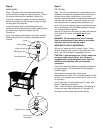Special offers from our partners!

Find Replacement BBQ Parts for 20,308 Models. Repair your BBQ today.

Buy Weber Grill Parts. It couldn't be easier. Find your Weber parts here.

15
Figure 11
Step 11
Check for gas leaks
WARNING: Check for gas leaks every time any gas
fitting is disconnected and reconnected.
You will need: a soap and water solution and a rag or
brush to apply it.
Note - Since some leak test solutions, including soap
and water, may be slightly corrosive, all connections
should be rinsed with water after checking for leaks.
To perform leak checks: Turn test valve to the CLOSED
position. Figure 11. Turn tank valve ON
(counterclockwise). Check for leaks by wetting the
connections with the soap and water solution and
watching for bubbles.
Check the following connections, as shown in figure 11:
a) Test valve to regulator connection.
b) Quick disconnect fitting to LP tank connection.
(a)
(b)
Test valve in CLOSED position Test valve in OPEN position
DANGER
Do not use an open flame to check for
gas leaks. Be sure there are no sparks or
open flames in the area while you check
for leaks. This will result in a fire or
explosion which can cause serious bodily
injury or death and damage to property.
If bubbles occur, or if a bubble enlarges, the connection
is leaking. Turn OFF the gas at LP tank.
If the leak is at connection a) DO NOT OPERATE THE
BARBECUE. Contact your dealer.
If the leak is at connection b) disconnect and reconnect
the quick disconnect fitting. Turn the gas back on and
recheck with the soap and water solution.
WARNING: If leak persists after tightening the
connection, turn OFF the gas at LP tank. DO NOT
OPERATE THE BARBECUE. Contact your dealer.
After completing the leak checks:
a) Turn the LP tank valve OFF (clockwise) and rinse
connections with water.
b) Turn the test valve to the OPEN position (parallel to
the hose). Figure 12.
Test valve must be in OPEN
position when operating grill
Figure 12


















